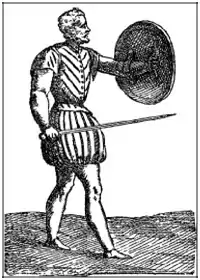Venetian school of fencing
Within the Italian school of swordsmanship of the Renaissance, a specifically Bolognese tradition is sometimes postulated for the 16th century. In the early 17th century, there appears to have been a special local emphasis on rapier fencing in Venice, specifically associated with Nicoletto Giganti.[1] and Giacomo di Grassi. As elsewhere in Europe, the tradition of classical fencing persisted in Venice until the beginning of the 19th century.[2][3]
The Venetians were masters of the art of fencing, and shared with their colleagues of Bologna the sound principles of fencing known as Bolognese or Venetian.[4] The earliest writings on Venetian fencing focused on the properties of different parts of the blade which were used in defense and offense. From this approach arose the concept of the "center of percussion", the ideal spot on the blade at which a blow should be struck.[5] The blade was divided into four parts: the first two parts from the hilt should be used for protection; the third one near the "center of percussion" was used for striking; and the fourth part at the tip was used for pricking.[3] In the beginning of the sixteenth century, French nobles earned a reputation as excellent swordsmen, however it was customary for them to go secretly to Italy to learn martial skills in the schools of Bologna or Venice.[3]
Nicoletto Giganti has been described as "a fruitful innovator in fencing."[4] Giganti was a 17th-century Italian rapier fencing master. The frontispiece of his 1606 work [6] names him as "Nicoletto Giganti, Venetian", although evidence suggests he or his family moved to Venice from the town of Fossombrone, in Le Marche, Central Italy.[7] Little is known of Giganti's life, but in the dedication to his 1606 treatise, he counts professional experience arising from 27 years work, whereas the Giganti family of Fossombrone were lesser nobility, long in the military service of Venice.[8]

Another representative of the Venetian school of fencing was Giacomo di Grassi, an Italian fencing master who wrote the fencing treatise Ragione di adoprar sicuramente l'Arme, si da offesa come da difesa in 1570. The Venetian master of fencing developed his own theory of the fencing art. His method was much simpler than the technical elements of Achille Marozzo. There are some typical examples of his systems in the works by Henry de Saint Didier and Vincentio Saviolo.
References
- Tom Leoni, Venetian Rapier: Nicoletto Giganti's 1606 Rapier Fencing Curriculum, FreeLance Academy Press, 2010
- Mariani, Filippo; Stocco, Francesco; Crovato, Giorgio (2007). La reinvenzione di Venezia: tradizioni cittadine negli anni ruggenti [The Reinvention of Venice, Civic Traditions from its Ascendant Years]. Il poligrafo.
- Castle, Egerton (2017). Школы и мастера фехтования. Благородное искусство владения клинком [Schools and Masters of Fencing: the Noble Art of Swordsmanship] (in Russian). Litres.
- Molmenti, Pompeo (1908). Venice: its individual growth from the earliest beginnings to the fall of the republic. 6. A.C. McClurg & Co.
- Evangelista, Nick (1995). The Encyclopedia of the Sword. Greenwood. p. 100. ISBN 9780313278969.
- Giganti, Nicoletto (1606). Scola, overo, teatro: nel qual sono rappresentate diverse maniere, e modi di parare et di ferire di spada sola, e di spada e pugnale. Venice.
- Lancellotti, Francesco Maria (1796). "Quadro letterario degli uomini illustri della città di Fossombrone". In Colucci, Giuseppe (ed.). Antichità picene, XXVIII. Fermo. p. 33.
- Calcaterra, Francesco (2012). Corti e cortigiani nella Roma barocca. Rome. p. 76.
Further reading
- Leoni, Tom (2015). Venetian Rapier: The School, or Salle: Nicoletto Giganti’s 1606 Rapier Curriculum with New Introduction, Complete Text Translation and Original Illustrations. Freelance Academy.
- Giganti, Nicoletto (2013). The 'lost' Second Book of Nicoletto Giganti (1608): A Rapier Fencing Treatise Rediscovered and Translated. Translated by Terminello,, Piermarco; Pendragon, Joshua. Fox Spirit.CS1 maint: extra punctuation (link)
- Cent'anni di scherma a Venezia (1889—1989). A cura di Dante Galante. Venezia 1989.